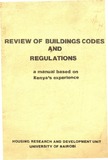| dc.description.abstract | In order to understand the deficiencies of th€ building codes and regulations in Kenya one has to recall, even momentarily, what. happerield in Europe nearly a 'century ago. •Formal r-u i.Ld.i.nq control of housing development was created originally in Europe at the
end of the nineteenth century in order to combat the unpleasant odours and sights and, later, public health dangers created by the insanitary living conditions of the overcrowded urban poor as a result of the Industrial Revolution. The manpower needs of
the new factories created at the expense of the earlier small scale rural industries, produced an urgent demand for vast
quantities of cheap. accommodation close to the factories. As a result large numbers of dwellings were quickly constructed at
minimum cost and with the minimum of fac~lities. The lack of proper sewerage and refuse disposal aggravated by the
overcrowded conditions Of both buildings and whole areas of the urban centres, created ideal breeding grounds for major outbreaks • • of diseases. The spread.of these diseases tp the better accommodated and more educated (and therefore mo re vociferous): members of the community, together with the emergence of ph i.Lan t.hrep.ica Ll.ymt.nded organisations and individuals creat.ed an impetus to find means of providing more sanitary condi. tion"s'. The simultaneous initial development of local authorities with powers to order and manage the life and development of the ~rpan area, provided the means and the vehicle,for the application of
these improvements.Thus the early Public Health Acts were born. Their objectives were to prohibit conditions to arise whereby the health of the public at large would be threatened. Thus water supplies either from wells, standpipes or individual piped supplies had to be
uncontaminated; human waste and refuse had to be collected and disposed of in a clean sanitary manner. Subsequently the controls
were extended to cover the construction of buildings to ensure structural stability, weather resistance, minimum levels of
lighting and ventilation. | en_US |



